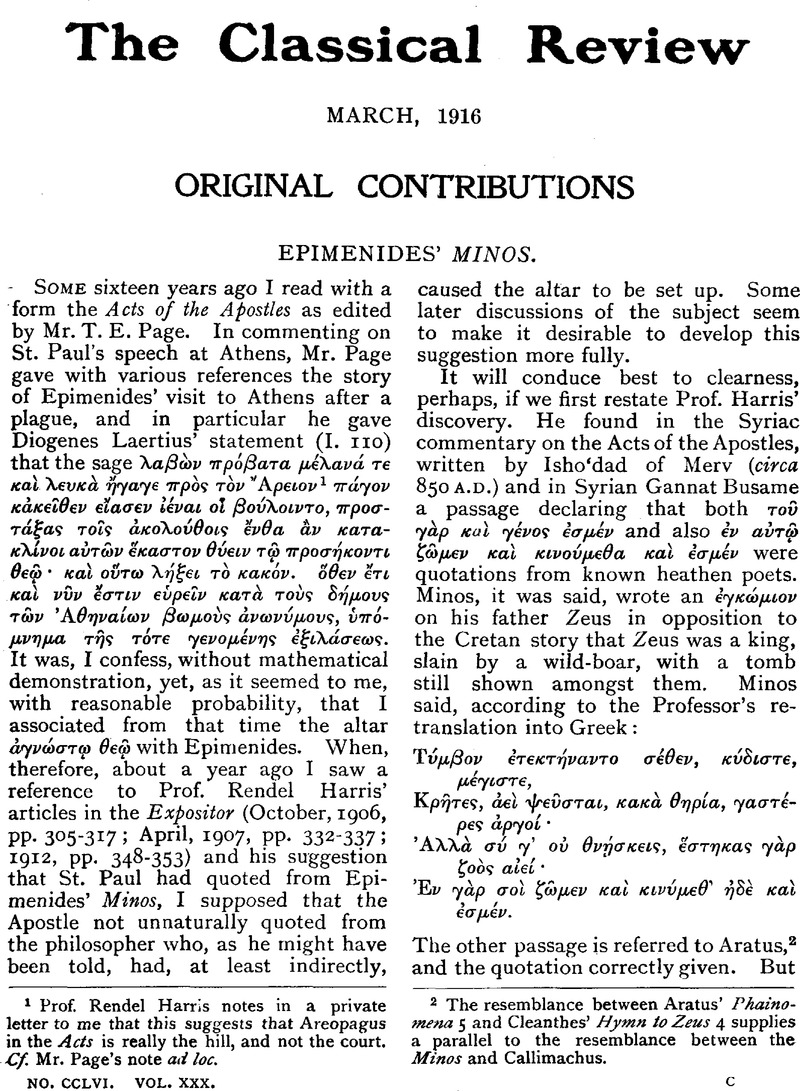Article contents
Abstract

- Type
- Original Contributions
- Information
- Copyright
- Copyright © The Classical Association 1916
References
page 33 note 1 Prof. Rendel Harris notes in a private letter to me that this suggests that Areopagus in the Acts is really the hill, and not the court. Cf. Mr. Page's note ad loc.
page 33 note 2 The resemblance between Aratus' Phainomena 5 and Cleanthes' Hymn to Zeus 4 supplies parallel to the resemblance between the Minos and Callimachus.
page 34 note 1 Imitated by Dionysius' Perieget. and Nonnus.
page 35 note 1 It confirms the view developed in the text that in the short spurious commentary (vol. xi.) we read, ![]() , Callimachus scilicet.
, Callimachus scilicet.
page 35 note 2 Augustine, contra Adv. Leg.; Chrysostom, Serm. 3. Epist. ad Tit.; Origen, adv. Celsum, lib. 3, chap. 43 (Callimachus) and Theodoret. The origin of the proverb is variously traced by Eustathius and a scholiast on Callimachus to Idomeneus' dishonest distribution of Trojan spoils, and Antiochus ![]() , book 2 (in Athenodorus of Eretria ὑπομνματα, book 8), to Medea's cursing of him for pronouncing her less beautiful than Thetis. Cf. Ptol. Hephaestion (of Trajan's date) in Photius Biblioth. p. 483; Zenob. iv. 62, and Meursii Cret. p. 233.
, book 2 (in Athenodorus of Eretria ὑπομνματα, book 8), to Medea's cursing of him for pronouncing her less beautiful than Thetis. Cf. Ptol. Hephaestion (of Trajan's date) in Photius Biblioth. p. 483; Zenob. iv. 62, and Meursii Cret. p. 233.
page 35 note 3 Cf. Socr. III. 26 and Nicephorus X. 26.
page 35 note 4 Cf. Clement Alexandr. I. 14 and Athanasius, de Incarn. xiii.
page 36 note 1 This notation is attested by Oxyrhynch. Papyr.
page 36 note 2 The true date of Solon's archonship seems to be 591/0 (Sandys' Aristotle Const. of Ath. p. 50), and this followed Epimenides' visit.
page 36 note 3 Laws 642 D.
page 36 note 4 Suidas' date, Ol. 30=660/56 B.C., may be due to taking him to have lived 157 years. His date, Ol. 44, for the (first) purification may show that he reckoned him to be 57 years of age at that time. It is possible that Suidas' date for the birth is right, and that the Cretan 299 conceals 314 half-years. This would not affect our other figures.
page 36 note 5 This agrees with a communication of Prof. Rendel Harris, ‘we ought to translate ![]() anarthrously, as “to an unknown god.”’
anarthrously, as “to an unknown god.”’
- 2
- Cited by




